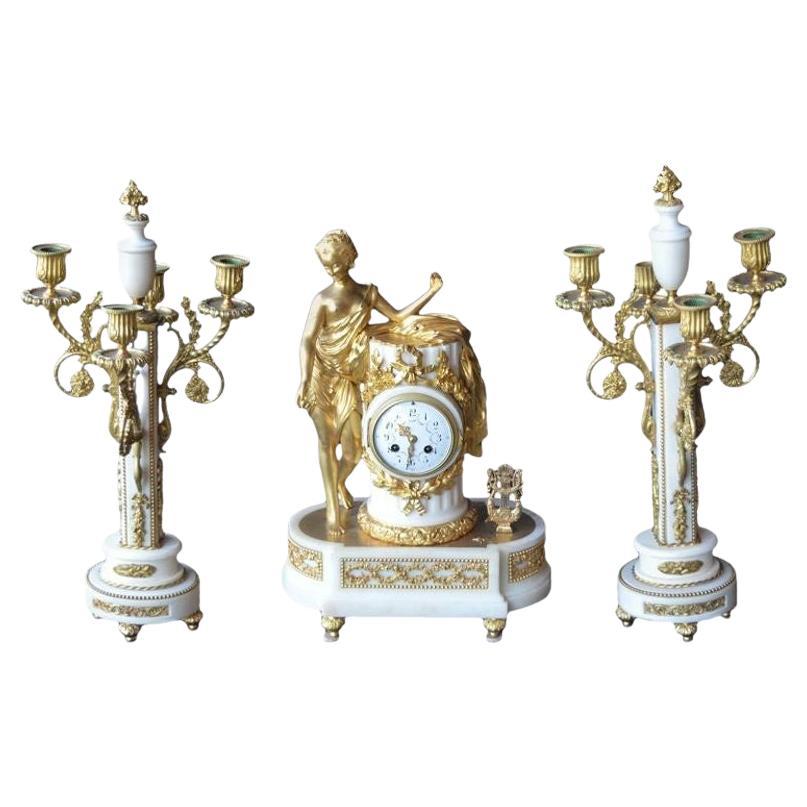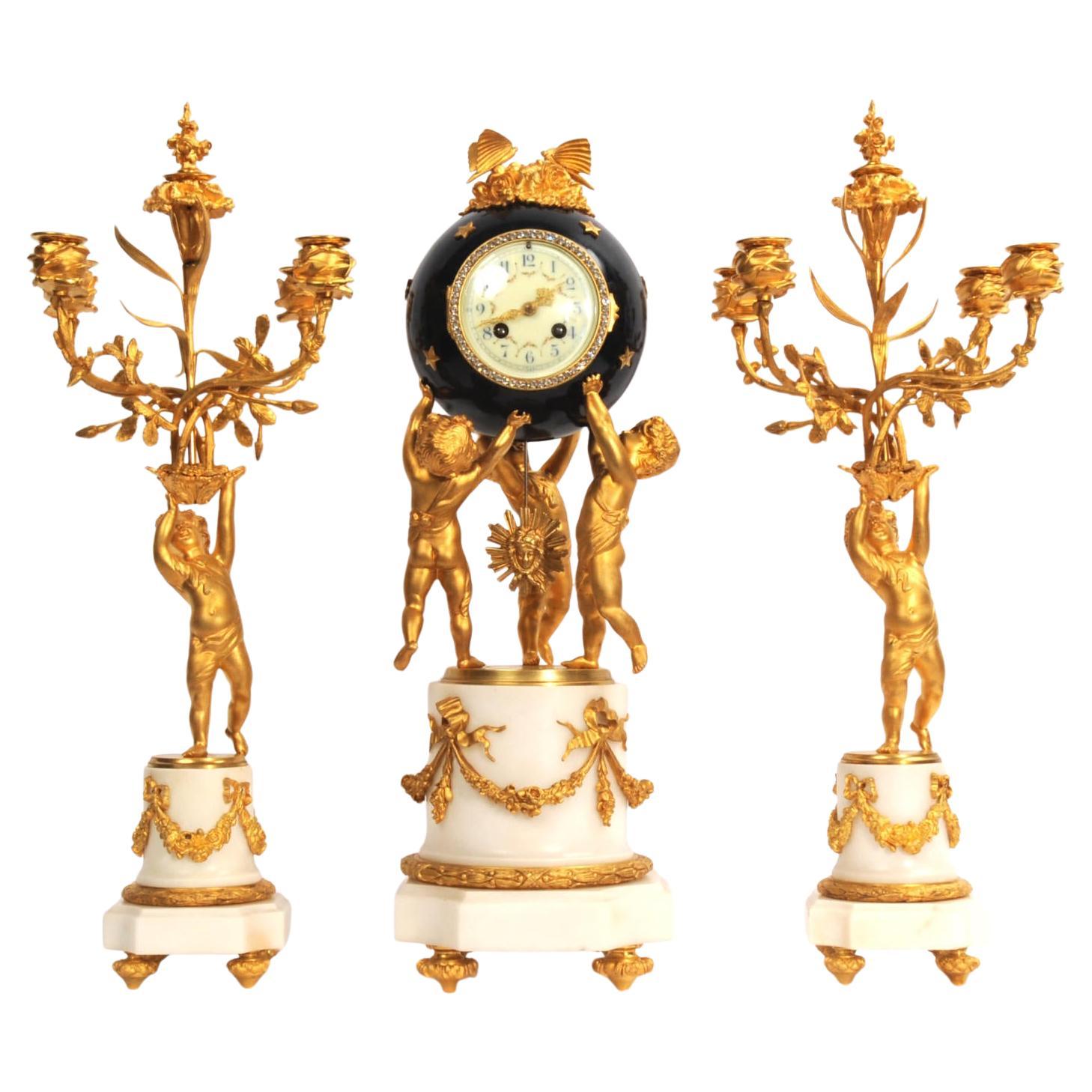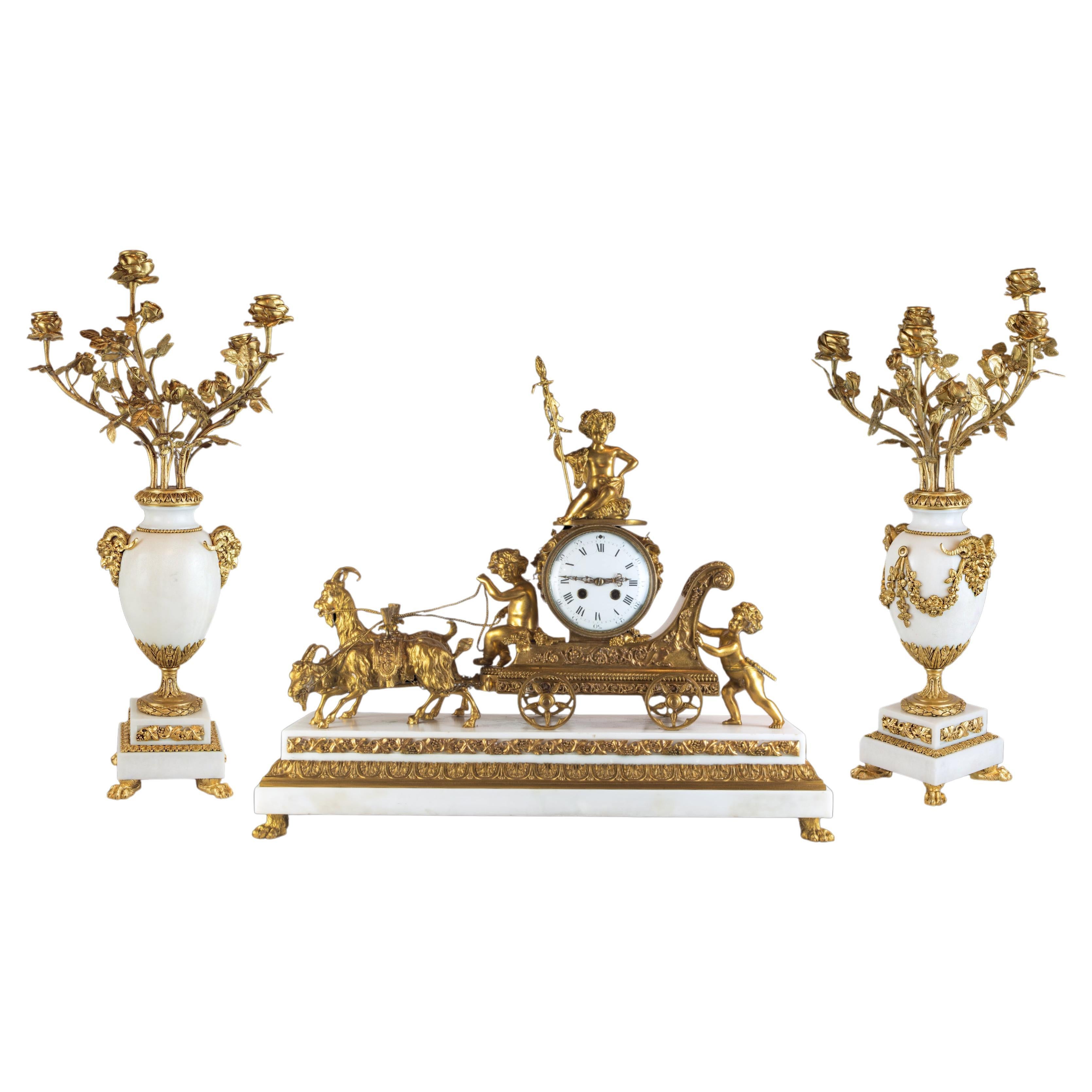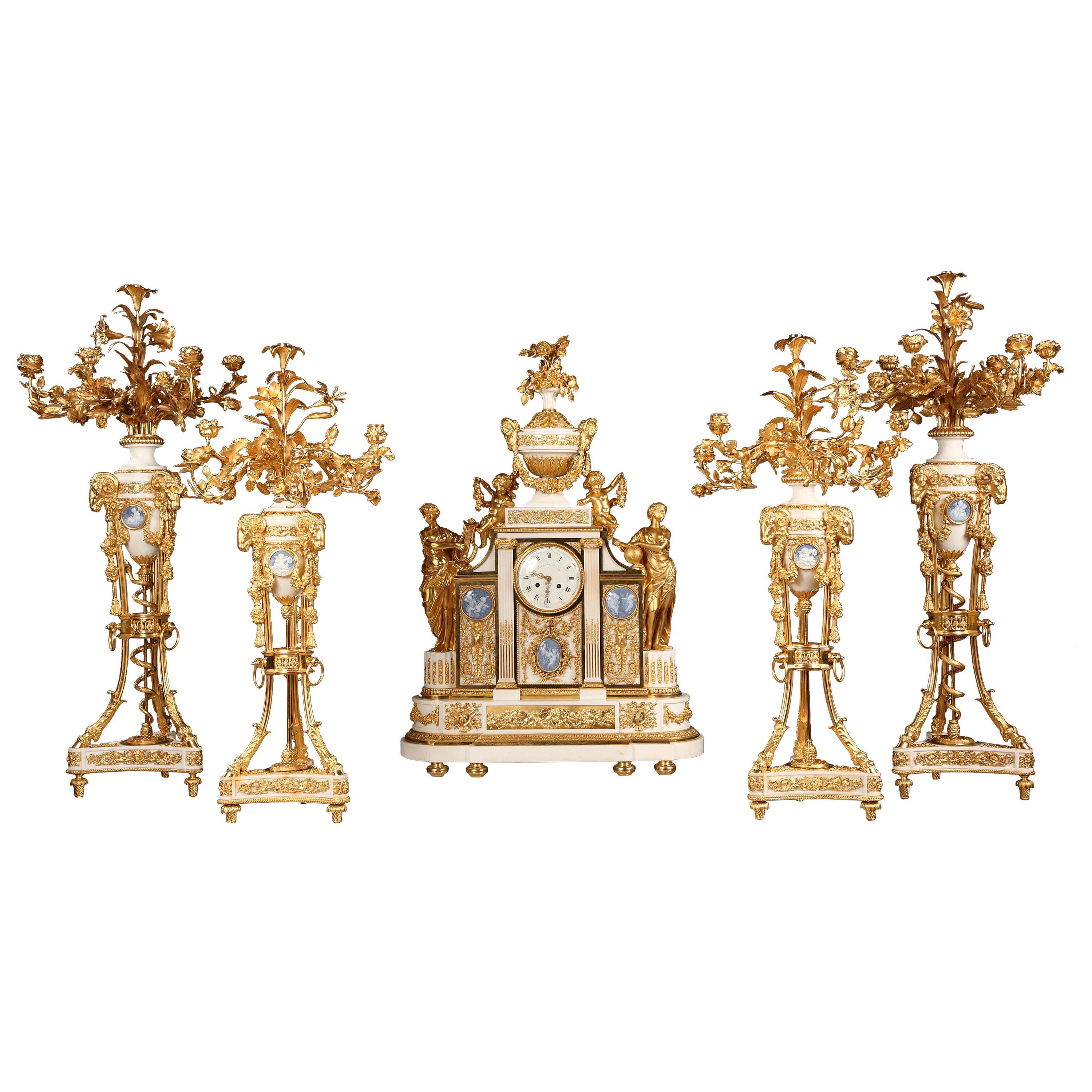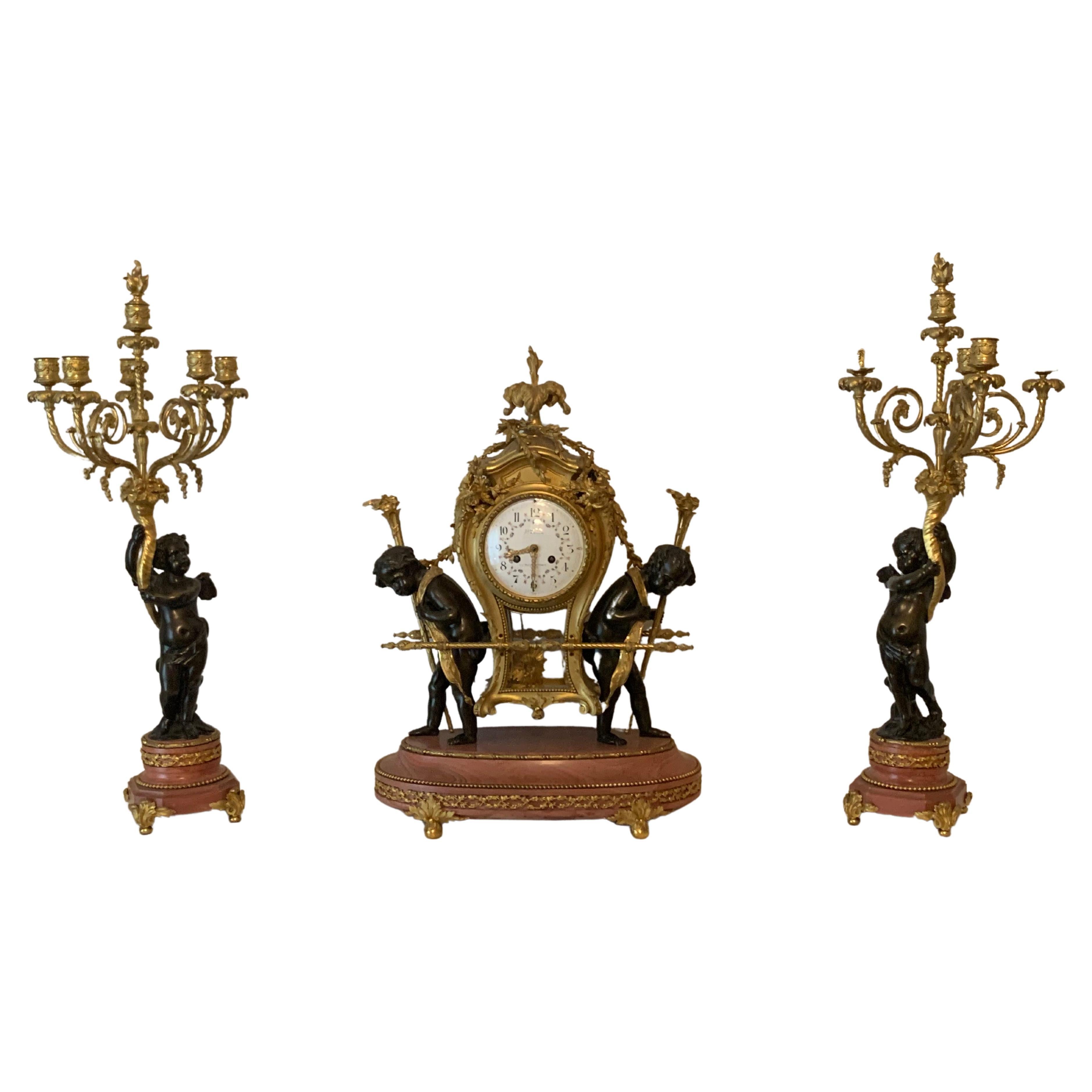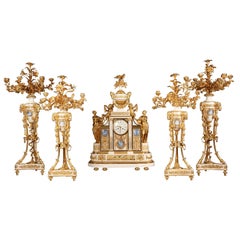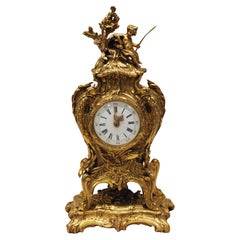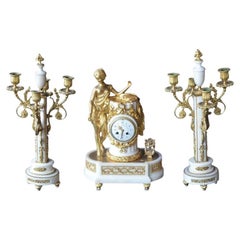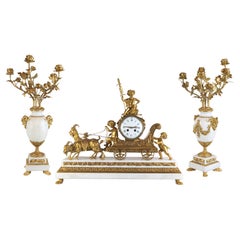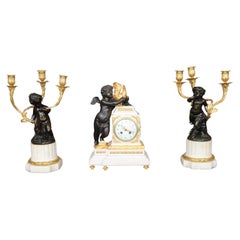Items Similar to "Geniuses of the Arts" Gilded Bronze and Marble Clock Set by G. Fabre, c. 1900
Want more images or videos?
Request additional images or videos from the seller
1 of 10
"Geniuses of the Arts" Gilded Bronze and Marble Clock Set by G. Fabre, c. 1900
About the Item
Dial signed G. Fabre, 4 rue des Filles du Calvaire, Paris
Clockwork signed Samuel Marti – Médaille d’Or 1900
A Louis XVI style gilt-bronze and statuary Carrare marble clock set, consisting of a clock and a pair candelabra. The clock is surmounted by two putti, leaning the dial, representing the “Geniuses of the Arts”, poetry and painting. The base is adorned with neoclassical decorative elements such as scrolls, rows of pearls and foliate feet. The ensuite candelabra, made of ormolu and white marble, are composed of Bacchic children, after 18th century models by Clodion. Each holding two light arms, dressed in leopard skins and vine branches, a wineskin at his feet.
Dimensions : Clock / height 47 cm (18 1/2 in.); width 40 cm (15 3/4 in.); depth 13 cm (5 in.)
Candlesticks / height 50 cm (19 2/3 in.); width 26 cm (10 1/4 in.); depth 14 cm (5 1/2 in.).
Gilbert Fabre is listed at the turn of the twentieth century among manufacturers of quality bronzes. They also produced many clocks and mantle decorations, whose works were manufactured by the wellknown Samuel Marti, installed Rue Charlot in Paris in 1860. Gilbert Fabre in 1919 sold his business to Chardon company, an art foundry from Belgium in 1878 then. ref. 1249
- Creator:Samuel Marti (Clockmaker),G. Fabre (Maker)
- Dimensions:Height: 18.51 in (47 cm)Width: 15.75 in (40 cm)Depth: 5.12 in (13 cm)
- Sold As:Set of 3
- Style:Louis XVI (In the Style Of)
- Materials and Techniques:
- Place of Origin:
- Period:1900-1909
- Date of Manufacture:circa 1900
- Condition:
- Seller Location:PARIS, FR
- Reference Number:Seller: 12491stDibs: LU3860311762501
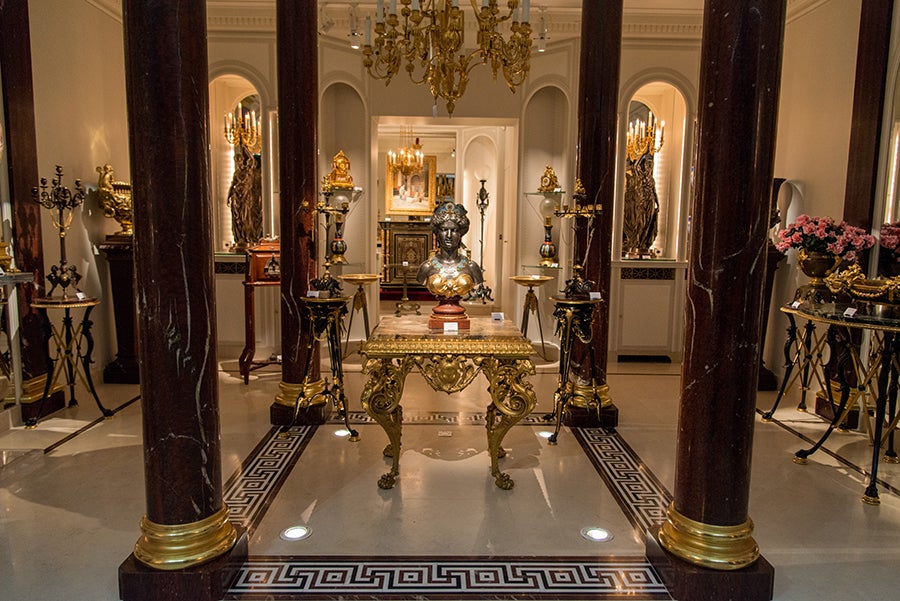
About the Seller
4.9
Gold Seller
Premium sellers maintaining a 4.3+ rating and 24-hour response times
Established in 1997
1stDibs seller since 2018
85 sales on 1stDibs
Typical response time: <1 hour
Associations
International Confederation of Art and Antique Dealers' Associations
- ShippingRetrieving quote...Shipping from: Saint Ouen, France
- Return Policy
Authenticity Guarantee
In the unlikely event there’s an issue with an item’s authenticity, contact us within 1 year for a full refund. DetailsMoney-Back Guarantee
If your item is not as described, is damaged in transit, or does not arrive, contact us within 7 days for a full refund. Details24-Hour Cancellation
You have a 24-hour grace period in which to reconsider your purchase, with no questions asked.Vetted Professional Sellers
Our world-class sellers must adhere to strict standards for service and quality, maintaining the integrity of our listings.Price-Match Guarantee
If you find that a seller listed the same item for a lower price elsewhere, we’ll match it.Trusted Global Delivery
Our best-in-class carrier network provides specialized shipping options worldwide, including custom delivery.More From This Seller
View AllImportant Five Pieces Marble and Gilded Bronze Clock Set, France, Circa 1860
By Henri Picard
Located in PARIS, FR
Marked on the dial Furet & Bon, Hrs du Roy, à Paris
Measures: Clock – Height 98 cm (38 1/2 in.), width 70 cm (27 1/2 in.), depth 25 cm (9 3/4 in.)
Candelabra – Height 116 cm (45 ...
Category
Antique 1860s French Louis XVI Mantel Clocks
Materials
Marble, Bronze
Leila and the Giaour Gilded Bronze Clock, France, Circa 1830
Located in PARIS, FR
Dial signed Polti Frères
Measures: With base or glass: Height 61 cm (24 in.), width 51,5 cm (20.3 in.), depth 23.5 cm (9,2 in.)
Without base: Height 52 cm (20,5 in.), width 42 cm (16.5 in.), depth 12.5 cm (4.9 in.)
Important philhellenic clock in burnished and amati gilded bronze, finely chiseled, representing on the terrace a couple elegantly dressed in "the turkish style", and richly decorated with foliage, scrolls and flowers. The feet, decorated with water leaves, rest on an oval wooden base covered with a globe.
The theme of the clock comes from The Giaour, a fragment of a Turkish Tale, an English poem by Lord Byron published in may 1813 which tells the thwarted love of a Venetian, the Giaour – term by which the Turks designate infidels and especially Christians – and of Leila, a slave belonging to Hassan’s seraglio, military leader of a Turkish province. The betrayal of Leila discovered, she will be thrown into the sea and her lover will avenge her by killing Hassan, then taking refuge in a monastery.
Symbol of prestige and modernity, the decorative clocks are a reflection of the taste of the era of a wealthy bourgeoisie and may be the subject of diplomatic gifts or between individuals.
Beyond the purely decorative aspect of such objects, watchmaking in the 19th century is part of a subtle mix of political, historical and literary references.
This philhellenic movement converning the West finds a particular echo in France, one of the countries with the United Kingdom and Russia having suported the Greeks during their war of independance (1821-1830) to free oneself from the grip of the Ottoman Empire. Many clocks...
Category
Antique 1830s French Mantel Clocks
Materials
Bronze
$12,565 Sale Price
55% Off
Neo-Egyptian Bronze and Marble Clock Attributed to G.Servant, France, Circa 1870
By Georges Emile Henri Servant
Located in PARIS, FR
A black and red marble clock in the shape of an Egyptian temple attributed to G. Servant, flanked by double columns inscribed with hieroglyphs and ornated with a winged uraeus, all made in two patina bronze. The clock is surmounted by a patinated bronze sphinx. Resting on four bronze faces wearing the nemes and terminating in lion paw feet.
Georges Emile Henri Servant (circa 1828-1890) who took over his father in 1855 at their foundry, rue Vieille-du-Temple, in Paris, specialized in the production of neo-Egyptian style clocks, very popular in France since 1860s, and also the making of Greek style decorative objects. He drew considerable attention to the high quality of his bronzes at the 1855 Paris Universal Exhibition and then at the 1862 London Exhibition. At this time Servant exported up to 40% of his production, principally to the United States, where for instance, his sphinx clocks were sold with great success by Louis Tiffany Inc. or Hamann & Roche of New York (A similar clock is now exposed at the Metropolitan Museum of Art, New York). But his success came really at the 1867 Paris Universal Exhibition, where he was awarded a gold medal for his neo-Greek and Egyptian works (Les Merveilles...
Category
Antique 1870s French Egyptian Revival Mantel Clocks
Materials
Marble, Bronze
"The Source" Gilt bronze Clock attr. to L. Messagé & F.Linke, France, circa 1890
By François Linke
Located in PARIS, FR
Charming clock in the shape of a Rocaille-inspired cartel in chiseled and gilded bronze. Scalloped marine-inspired decor representing a trophy with oars, dolphins, reeds and flowers ...
Category
Antique 1890s French Rococo Revival Table Clocks and Desk Clocks
Materials
Bronze, Enamel
Fine Neo-Greek Clock Set by H. Houdebine, France, Circa 1867
By Henri Houdebine
Located in PARIS, FR
Dial signed H. Houdebine, Fabricant de Bronzes, Rue de Turenne 64, Paris
and clockwork signed Japy Frères & Cie – Médaille d’Honneur
A very fine neo-Greek style clock set made up of...
Category
Antique 1860s French Greek Revival Table Clocks and Desk Clocks
Materials
Bronze
$10,238 Sale Price / set
29% Off
Neo-Egyptian Marble Clock Attributed to G. Servant, France, Circa 1870
By Georges Emile Henri Servant
Located in PARIS, FR
Black and red marble pyramid shaped Egyptian style clock attributed to G. Servant, surmounted by a patinated bronze figure representing the Egyptian goddess Isis sitting on her throne. Wearing the Hathor hairdress (the solar disc surrounded by the sacred cow horns), she holds in her right hand the Ouadj, the goddesses scepter surmounted by a canopy of papyrus, symbolizing health and eternal youth and in her left hand, the cross of life Ankh, symbol of rebirth and eternity.
That Egyptian style in fashion since Napoleon the First and his military campaigns in Egypt around 1799 was rediscovered in France in the 1830's and above all in the 1860's. Some renowned French artists, such the sculptors and bronze-casters Guillaume Denière (1815-1903), Emile Hébert (1828-1893) et Georges Servant (1828-1890), presented at the 1867 and 1878 Paris Universal Exhibitions, an a-part section dedicated to their Egyptian style production. Their shows drew then considerable attention from the public and the wealthy collectors. During the 1867 Universal Exhibition, one could admire the Stand realized by the French silversmith-jeweller Gustave Baugrand (1826-1870), where his works executed in most Fine materials took inspiration from the Egyptian Antiques, exhibited then in the Louvre museum.
Georges Emile Henri Servant (1828-c.1890), who took over his father in 1855 at their foundry, rue Vieille-du-Temple, in Paris, specialized in the production of neo-Egyptian style clocks, very popular in France since 1860’s, and also the making of Greek style decorative objects. He drew considerable attention to the high quality of his bronzes at the 1855 Paris Universal Exhibition and then at the 1862 London Exhibition. At this time Servant exported up to 40% of his production, principally to the United States, where for instance, his clocks were sold with great success by Louis Tiffany Inc. or Hamann & Roche of New York. But his success came really at the 1867 Paris Universal Exhibition, where he was awarded a gold medal for his neo-Greek and Egyptian works (Les Merveilles...
Category
Antique 1870s French Egyptian Revival Table Clocks and Desk Clocks
Materials
Marble, Bronze
You May Also Like
French Marble and Gilded Bronze Clock Set
Located in Los Angeles, CA
Detailed marble French clock set embellished with gilded bronze.
Category
Antique Early 1800s French More Clocks
Materials
Marble, Bronze
$6,400 / set
Fine Ormolu and Marble Cherub Clock Set by H Luppens Paris
By Samuel Marti, H. Luppens & Cie
Located in Belper, Derbyshire
A large and magnificent clock set by the renown bronze founder H Luppens of Brussels. Classically modelled in the Louis XVI style, the clock features three ormolu cherubs toiling to ...
Category
Antique 19th Century French Louis XVI Mantel Clocks
Materials
Marble, Ormolu
Fine Three pice clock set Of Thor's Chariot by Samuel Marti
By Samuel Marti
Located in New York, NY
A fine antique French Gilt bronze and white marble garniture set of three putti playing in Thor's chariot. Rendered in crisp and bronze, a pair of Rams in dynamic poses pull the char...
Category
Early 20th Century French Louis XVI Mantel Clocks
Materials
Statuary Marble, Bronze, Gold Leaf
French Louis XV Style Marble and Bronze Ormolu Clock Set By Samuel Marti C. 1890
By Samuel Marti
Located in Swedesboro, NJ
Dimensions - ( Clock - H: 15in W: 10 1/2in D: 6in ) ( Candelabras - H: 17 1/2in W: 10in D: 6 1/2in )
This antique French Samuel Marti Louis XV style figural marble and bronze mounte...
Category
Antique Late 19th Century French Louis XV Mantel Clocks
Materials
Marble, Bronze, Ormolu, Enamel
$7,160 Sale Price / set
20% Off
Clock Set in Marble and Bronze by F.Gervais
By Ferdinand Gervais
Located in Los Angeles, CA
Truly unique clock set in pink marble and bronze decorative piece of art
the clock is modelled in the image of an 18 century sedan chair that is covered ...
Category
Antique 1870s French Louis XVI Mantel Clocks
Materials
Marble, Bronze
Clock set 3 pieces marble and bronze with cherub
Located in Los Angeles, CA
Magnificent clock set three pieces executed by Prosper Roufoel working 26 place Vendome a Paris, one of the most pretigious place in paris where is the great jewwelers and the ritz ...
Category
Antique 1880s French Louis XVI Mantel Clocks
Materials
Marble, Bronze
$27,000 Sale Price / set
22% Off
Recently Viewed
View AllMore Ways To Browse
Marble 1900
Light Object 15
Pair Light Arts
Bronze Clock With Marble Base
Clock Dress
Gilded Bronze Mantel Clock
Twos Company Clock
Light 5 Branches
Mantle Decorations
Gilded Putti
Medaille Bronze
Medaille Antique
Pearl Clock
Antique Painting Clock
Clocks Circa 1860
1900 Mantel Clocks
Mantel Clock Sets Marble And Bronze
Marble And Gilt Bronze Clock Set
